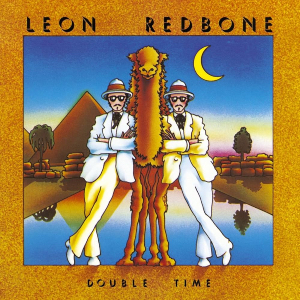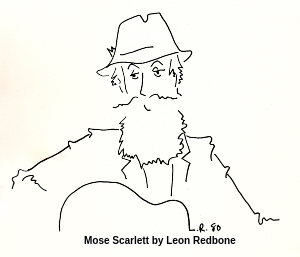Music journalism, books and more
Mose and Leon - minstrels from another age
As troubadours, Toronto’s Mose Scarlett and Leon Redbone were cut from the same vintage cloth. Both came up through the Yorkville scene of the late 1960s, performing songs from bygone eras–jazz, blues, ragtime and swing–and always dressed for the part: Scarlett neatly turned out in a three-piece suit and fedora or, more informally, a waistcoat and workingman’s flat cap; Redbone immaculate in a dark suit, a bow or string tie, topped by a fedora, straw boater, a Panama hat or even, occasionally, a pith helmet. They could have been arch rivals, instead they were good friends.
When Mose and Leon died on the same day—May 30, 2019—many who knew the pair felt the coincidence as fitting as it was strange. Each had graduated from coffeehouses to concert halls and folk festivals and recorded albums that were cherished by lovers of old blues and Tin Pan Alley pop. Redbone, with his Groucho Marx moustache and mysterious biography, became more the celebrated of the two, thanks to Bob Dylan’s stamp of approval and resulting appearances on Saturday Night Live and The Tonight Show with Johnny Carson.
 Leon guarded his real-life details like state secrets, leading to endless snooping by reporters who didn’t like being fooled. He started out performing at Ryerson’s Pornographic Onion using just the name “Sonny.” If people wanted to reach him, they could call Cue Billiards at the Bloor subway station where he often played pool and just ask for him. If he wasn’t there, the pool hall would take a message. When Rolling Stone pressed Redbone for his age and who his parents were, he told the writer he was 304, that his father was Italian violinist Paganini and his mother was Swedish opera singer Jenny Lind. As for his place of birth, Redbone replied, “I only wish I knew.”
Leon guarded his real-life details like state secrets, leading to endless snooping by reporters who didn’t like being fooled. He started out performing at Ryerson’s Pornographic Onion using just the name “Sonny.” If people wanted to reach him, they could call Cue Billiards at the Bloor subway station where he often played pool and just ask for him. If he wasn’t there, the pool hall would take a message. When Rolling Stone pressed Redbone for his age and who his parents were, he told the writer he was 304, that his father was Italian violinist Paganini and his mother was Swedish opera singer Jenny Lind. As for his place of birth, Redbone replied, “I only wish I knew.”
Mose, on the other hand, was an open book. Born in Peterborough, Ont. to an electrical engineer father and former kindergarten teacher mother, he moved with his family to Ohio until he was 18, when he returned to Canada to avoid the Vietnam draft. Settling in Toronto, he met and befriended U.S. blues legend Lonnie Johnson, who’d taken up a Toronto residency, and became something of the master’s understudy. Before long, Scarlett was performing his own repertoire of age-old tunes in coffeehouses like the Nervous Breakdown and workshop gatherings at the Mariposa Folk Festival. According to his musician friend Ken Whiteley, “Mose really related to that sense of community and fellowship.”
 Another friend of Scarlett’s was Bruce Cockburn, who remembers him and Redbone as a study in contrasts. “When Leon was still known as Sonny,” says Cockburn, “he’d come over to Mose’s place and play harmonica while Mose and I jammed. A few years later, Sonny was suddenly this incredible guitar player called Leon Redbone, but had been very private about his development. And he never let anyone know where he lived. None of those things were true about Mose. He was at all not secretive, just a friendly, pretty open guy. And while he seemed like he was from another era in every way, it was not at all phoney or put on.”
Another friend of Scarlett’s was Bruce Cockburn, who remembers him and Redbone as a study in contrasts. “When Leon was still known as Sonny,” says Cockburn, “he’d come over to Mose’s place and play harmonica while Mose and I jammed. A few years later, Sonny was suddenly this incredible guitar player called Leon Redbone, but had been very private about his development. And he never let anyone know where he lived. None of those things were true about Mose. He was at all not secretive, just a friendly, pretty open guy. And while he seemed like he was from another era in every way, it was not at all phoney or put on.”
Leon, always behind dark sunglasses, kept his sources hidden. But guitarist Tony Quarrington believes it was from Mose that Leon first learned old material like “The Sheik of Araby” and Irving Berlin’s “My Walking Stick,” songs for which he became famous. “Leon put on a persona to do those songs,” says Quarrington, “but Mose was performing them very early on and they really seemed to be part of who he was. He never got to be as well-known as Leon, but he was never resentful about that. Mose left his own legacy and will be remembered for embodying that world of music and sharing it with whoever would listen.”
Mose Scarlett and Leon Redbone—remarkably similar yet entirely different.


